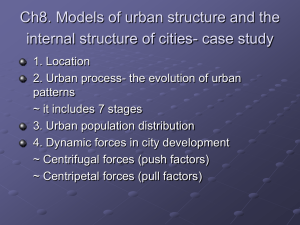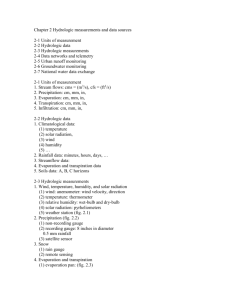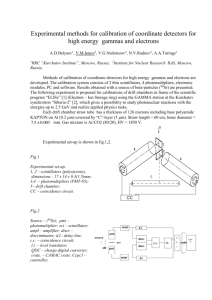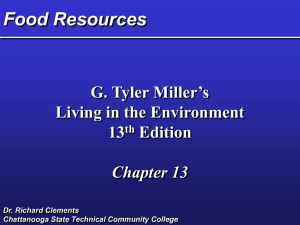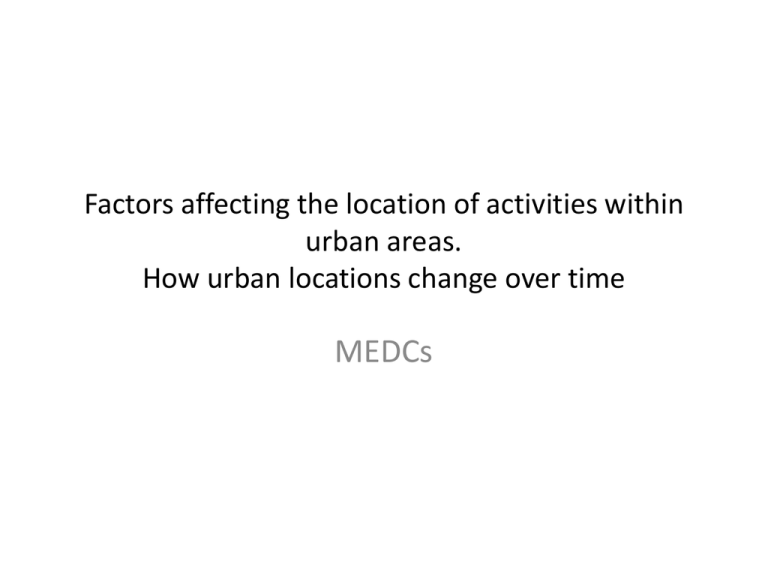
Factors affecting the location of activities within
urban areas.
How urban locations change over time
MEDCs
• Many factors influence the location of
different land uses in an urban area.
Physical influences
•
•
•
•
Rivers and estuaries
Altitude
Slope angle
Coasts and lakesides
– These will determine the value of the land
Social factors
•
•
•
•
Age and cultural value of buildings
Land ownership
Planning
Others, such as in-migration or quality of life
issues
The pattern and characteristics of
urban zones
• For each type of area, or zone, describe:– The location
– The land uses and functions
– The layout and road pattern
– The character of the buildings (size, density,
height, age)
– Processes that have caused the distinctive area
to develop
– Changes occurring
•
•
•
•
•
CBD
Inner city
Residential areas- low, middle and high
Suburbs
Urban-rural fringe
– Remember to note retailing, manufacturing,
services and residential
Processes and factors affecting the
urban pattern
• Figure 23 on page 38, C&U
Remember to include these as ‘changes’
•
•
•
•
•
•
•
•
Urban deprivation
Residential segregation
Gentrification
Urban renewal
Urban rebranding
Urban redevelopment
Counterurbanisation
Reurbanisation
W05
11 (a) Outline the characteristic functions of the
Central Business District (CBD). [7]
(b) How would you collect and record
information about land-use in the CBD, when
doing fieldwork in an urban area? [8]
(c) Assess the possible advantages and
disadvantages for shops (retail outlets) of
locating near the edges of urban areas rather
than centrally.
S07
• 5 Fig. 5 shows two processes occurring within a
large urban area in an MEDC.
• (a) Name the process shown by the dotted arrow
on Fig. 5. [1]
• (b) Explain why the filtering (lower income groups
moving into better housing) shown in Fig. 5 may
occur. [4]
• (c) Under what circumstances may newly-built
housing be located within the existing urban area
rather than on its outer edge? Support your
answer from a city or cities you have studied. [5]
W08
• 5 Figs 4A, 4B and 4C show the population age /
sex pyramids for three districts of the city of San
• Diego, USA.
• (a) Giving evidence from the figures, name the
district of San Diego which was likely to be:
• (i) the location of the state university;
• (ii) a residential suburb favoured by families. [4]
• (b) Explain briefly the economic factors which
help to create residential districts of different
• characteristics within many large urban areas. [6]
S09
5 Fig. 5 shows the planned layout of the central area of
Portland, Oregon, USA. In 2006 the city’s total
population was 563 000.
(a) Compare the character of land-use on the two sides
of the Willamette River. [5]
(b) New residential development is occurring at the
location marked X on Fig. 5, with the conversion of a
disused warehouse into high quality apartments.
Outline the possible advantages and disadvantages of
living at X, using the information in the figure and your
knowledge of urban areas. [5]
W10-12
6 Fig. 5 shows settlement dynamics in the
city of Chicago and its region, USA, in 2005.
(a) Describe the location of the areas of
decline shown in Fig. 5. [2]
(b) Compare the location of the areas of slow
growth and of expansion growth in Fig. 5. [3]
(c) Suggest reasons why Chicago is growing in
the areas shown in Fig. 5. [5]
W10-13
12 (a) (i) Describe briefly the character of
retailing (shops) in the Central Business
District (CBD) of large urban areas. [3]
(ii) Give two reasons why there may be little
residential population in central areas of
cities. [4]
(b) Describe one or more developments in a
large urban area you have studied and suggest
reasons why they occurred. [8]
(c) Assess the success of one or more
attempts to provide infrastructure (such as
transport, power supply and water supply) for
a city you have studied. [10]
S08
11 Study Fig. 5, which shows possible changes over
time in land values in an industrial city in an MEDC.
(a) Describe the changes in the relationship between
land value and distance from the CBD shown on Fig. 5.
[7]
(b) Suggest reasons why land in zone S increases in
value during the declining industrial stage.
Use examples to support your answer. [8]
(c) To what extent do you agree that re-urbanisation
(movement back to live in inner urban areas) has much
to offer to people? [10]




